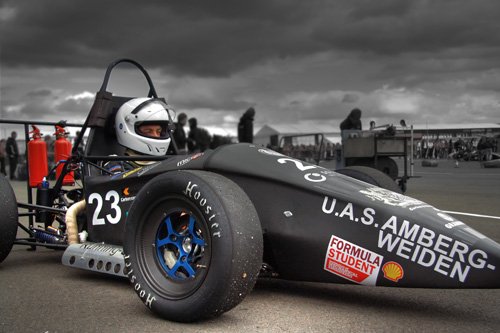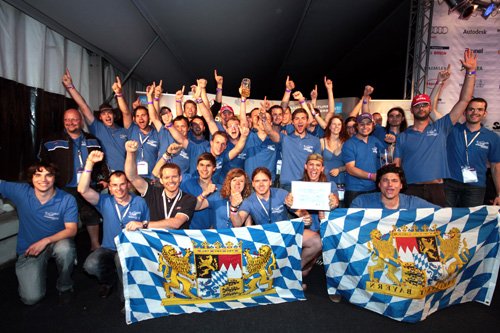It won "first place overall" on August 22 in Györ, Hungary. This meant that the Running Snail Racing Team, sponsored by the TraceParts, achieved the best result so far in its history, by taking first place overall in a Formula Student race series competition.
The team even managed to improve its position in all competitions during the races at Silverstone (England), Hockenheim (Germany) and Varano de Melegari (Italy). One particular highlight is the result in England where the Running Snail Racing Team moved up 16 places compared to last year's race. Coming 4th overall out of a total of 89 teams taking part, the Running Snail Racing Team just missed out on a place on the podium.
Trophies won during the 2010 season Airbus Lightweight Award (Silverstone)
An award from Airbus for the car with the best light construction concept which was able to complete the endurance race.
BMW Most Innovative Powertrain Award (Hockenheim)
An award for the car with the best drive concept, sponsored by BMW. This involved an assessment of innovation and competitiveness in terms of motor and powertrain.
-1st place Formula Student Hungary
-1st place - Design Event (Györ)
-1st place - Statics Overall (Györ)
-1st place - Skid Pad (Györ)
-1st place - Endurance (Györ)
-1st place - Dynamics Overall (Györ)
-2nd place - Acceleration (Györ)
-2nd place - Autocross (Györ)
-2nd place - Fuel Efficiency (Györ)
-3rd place - Business Plan (Györ)
-3rd place - Cost Event (Györ)
TraceParts GmbH wishes at this point to extend its warmest congratulations and hopes that the Running Snail Racing Team will get off to another successful start in the 2011 racing season.
Formula Student
The Formula Student is an international engineering competition that was founded in the US in 1981 and is now held in seven different countries each year. The main organizer is the largest engineering association in the world, the SAE (Society of Automotive Engineers).
The Formula Student is based on the idea that a company places an order for the construction of a race car prototype for amateur race car drivers. The vehicle has to fulfill certain requirements and therefore the competition is conceived in such a way that all aspects are evaluated, from the design to the cost control and from the marketing to the practical usability.
Disciplines
Static events: Static events involve analyses of the production process and account for around a third of the total number of points. This also includes the Engineering Design Event, in addition to individual disciplines such as the Cost Analysis Event, for example, where the teams have to provide total costs for building a vehicle as part of a low-production volume of 1,000 units, according to a predefined process cost key. In this case, the car's design is inspected by jurors, and the students must justify and defend the design decisions they made.
Skid pad: The skid pad is a horizontal figure eight whose circles have a diameter of 15.25 m. Each team may provide two drivers who have two tries each. The quickest try is the one that is evaluated.
Acceleration: The acceleration competition measures the acceleration of the car. The vehicle is accelerated from a standing position for 75 m. Each team may provide two drivers who have two tries each. The quickest try is the one that is evaluated.
Autocross: The car has to be steered along a handling course that is 800 m long. It includes straight lines, hairpin turns and slalom sections. Each team may provide two drivers and each driver has two tries. The quickest try is the one that is evaluated. The drivers do not have a training round.
Endurance: The endurance competition is the most important one. The vehicle has to be steered along a circular course that is 22 km long and resembles an autocross. The driver is changed after 11 km. In this process the engine and ignition have to be switched off and then start again without outside help. Usually several race cars are on the track at the same time, which however do not race against each other but against the clock. Special passing zones are furnished for faster cars. This competition is so important because it results in more than a third of all points and because nearly half of the cars do not make it through the entire 22 km.
Fuel Economy: Since 2009, instead of calculating the pure fuel consumption, the fuel economy is determined based on the distance covered during the endurance competition. This involves considering not only the exact fuel consumption, but also the time required and determining the fuel efficiency factor from this. The fuel efficiency factor can already be calculated following the change of driver after the first half of the endurance race. This means that a team can still pick up points, even after failure in the endurance competition, in the fuel efficiency section. The team with the highest fuel efficiency factor receives 100 points. The team with the lowest factor receives none. (Source: Article from Formula Student Germany. In Wikipedia, the free encyclopedia: http://de.wikipedia.org/...


